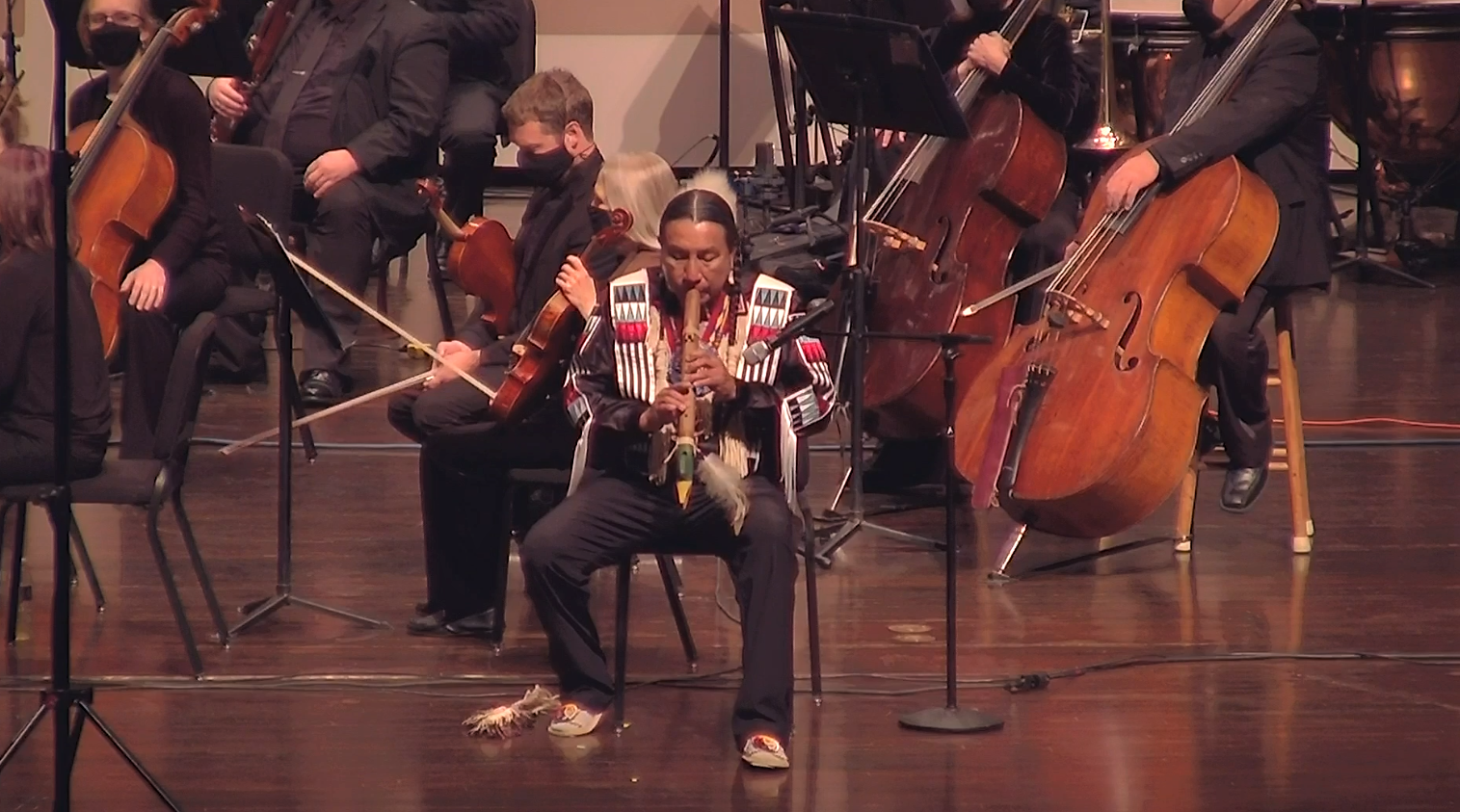One of the first people Delta David Gier met after being named music director of the South Dakota Symphony Orchestra in 2003 was Art Husboe, founder of the Center for Western Studies at Augustana University.
Husboe pulled Gier aside at a dinner party and gave him a copy of “Giants in the Earth,” Ole Rolvaag’s classic 1925 novel depicting the struggles and sacrifice of Norwegian pioneers in the Dakota Territory.
“If you want to understand people here, you have to read this book,” Husboe told the new conductor, who had come to South Dakota from the New York Philharmonic.
“Also,” added Husboe, “there’s an opera.”
That was news to Gier, an astute follower of 20th century American classical music who was not familiar with the piece.
 South Dakota News WatchStu Whitney
South Dakota News WatchStu Whitney
A seed of curiosity was planted, followed by a journey to revive an obscure and largely unheard opera as part of an exploration of music depicting immigrant and Native American experiences.
That journey will culminate with the South Dakota Symphony performing “Giants in the Earth” on April 26-27 at the Washington Pavilion in Sioux Falls, with much of the American opera community watching.
The event will commemorate the 100th anniversary of Rolvaag’s novel with only the third known presentation of Douglas Moore’s composition, which won the Pulitzer Prize for music in 1951.

For Gier, a world traveler who has made his home on the prairie, there is no better orchestra or setting to resurrect the opera and put it on proper display.
“The story takes place right here,” he said.
‘Triumph but also human cost’
Rolvaag, a 1901 graduate of Augustana Academy in Canton, set his novel in a fictitious Norwegian settlement between Flandreau and Sioux Falls. The book was based on stories he heard regarding a wagon train of pioneer families that arrived in the Dakota Territory in 1873.
Those tales came not from Rolvaag’s own family but from that of his wife, Jennie Berdahl, whose grandfather arrived in the United States from Norway in 1856. Less than two decades later, the Berdahls were part of a caravan of covered wagons that traveled from Fillmore County in southeast Minnesota and settled near what is now Garretson, about 20 miles northeast of Sioux Falls.
“Jennie had two brothers that were Rolvaag’s (Augustana) classmates, and they used to take him back to the family farm up by Garretson,” said Charles Berdahl, a retired Lutheran pastor in Sioux Falls whose grandfather was part of the wagon train. “That’s where he met Jennie and heard all the stories.”

Rolvaag, who taught and studied at St. Olaf College in Northfield, Minnesota, took a one-year leave of absence in 1923 to write “Giants in the Earth,” beginning the work from his writing cabin in northern Minnesota. He drew anecdotal research from Sioux Falls, where Jennie was staying with her father, Andrew.
“Letters went back and forth from Ole to Andrew, wondering about certain events and locations and talking about snow, locusts, sod houses and Indians,” said Berdahl, a former board member of the Nordland Heritage Foundation.

The fictional story describes how Per Hansa and his wife, Beret, respond to the challenges of forging a new life while preserving the culture of their homeland, an immigrant theme that still resonates today. The novel, first released in Norway, was translated to English and published in the United States in 1927, becoming required reading for many high school students.
“The book was not about romanticizing the pioneer experience,” said Berdahl. “It revealed triumph but also human cost, and I hope that the opera does as well.”
Seeking a unique American voice
Just as Rolvaag sought inspiration to meaningfully capture the pioneer experience, Moore was looking for a breakthrough as more than just a purveyor of folk operas.
Moore saw mid-20th century composers such as Leonard Bernstein and Aaron Copland in exploring distinctly American styles of symphonic expression and saw “Giants in the Earth” as ideal source material for that genre.

“Prior to that, a lot of American composers were imitating European composers,” said Gier, who conducted Bernstein’s “Overture to Candide” at his New York Philharmonic debut. “There was a lot of exploration and people saying, ‘What’s our American voice? What does that sound like?’ Moore was participating in that search.”
Building on his 1939 opera “The Devil and Daniel Webster,” Moore undertook an ambitious treatment of Rolvaag’s influential novel more than a decade later.

The three-act production, with a libretto (text) from Arnold Sungaard, features a “through-composed” style of continuous musical narrative to follow the text and propel the story, with less emphasis on self-contained solo pieces known as arias.
The opera premiered March 28, 1951, at Columbia University in New York, where Moore chaired the music department. The New York Times review noted that “the performance was of a high level” and that staging included “dancing, a wedding chorus, a baptismal hymn, and even a fight at the end of the second act.”
Opera claims prize with ‘freshness, beauty’
Praise for technical elements of the opera was more reserved, with the review criticizing Sungaard’s libretto as containing “too much talk and too much unnecessary literalism.”
As for Moore’s score, the reviewer wrote, “there are moments when the orchestra takes a hand, paints a scene, as in the fine opening stages, with the horn solo and the musical implication of the distances of the boundless plain. It is in the exterior music rather than moments of emotional intensity and melodic flight that Moore does the most.”
A Brooklyn Eagle theater critic lamented the show’s “rough prose” and sluggish start. But the review concluded that Moore’s production “when it finally gets under way, is tellingly expressive of a fine and real American theme.”

The piece was ascendant in the minds of the two-person Pulitzer Prize jury, which declared that “in no opera by an American is there music of such freshness, beauty, and distinctive character.”
That assessment has drawn scrutiny from some historians due to Moore’s influence on the award from his position as chair of the Columbia University music department, to which both Pulitzer jurists had connections.
A history of the music category commissioned by the Pulitzer Prizes in 2017 notes that Moore “served as a virtual silent partner and eminence grise (respected authority) in governing the award” in its early stages after the prize was established in 1943.
‘Giants in the Earth’ performed at UND
Moore’s most enduring work is the 1956 opera “The Ballad of Baby Doe,” a rags-to-riches love story based on real events in 19th-century Colorado that eclipsed his rendering of the Norwegian pioneer saga.
The fact that “Giants in the Earth” went unperformed over the ensuing decades was both cause and effect of the lack of recordings and score material that challenged Gier in his quest to revive the piece.
Moore completed a revised version of “Giants in the Earth” in 1963, cutting sections of the original score to tighten up the production. He died six years later, never having seen this version performed.
Sundgaard was in attendance, however, in April 1974 when the University of North Dakota Opera Co. presented “Giants in the Earth” at the Chester Fritz Auditorium in Grand Forks, an event billed as a world premiere and supported by the National Opera Institute.

Karl Rolvaag, son of the novel’s author and former governor of Minnesota, was scheduled to attend the premiere but had to cancel due to an illness in the family.
Two New York City Opera Co. members played the leads, supported by student performers, an arrangement that was praised by Sundgaard after the show, according to the Grand Forks Herald.
When someone noted that it was difficult to hear the words, the librettist (author) noted: “If you understand 80 percent of the words of any opera, you are lucky. If the action and story lines are clear, it’s not important to get it all.”
Confronting the cultural divide
For nearly 50 years after the UND performances, “Giants in the Earth” reverted to its forgotten status in the opera community.
Gier’s arrival in Sioux Falls, and his early introduction to the novel, fueled a desire to learn to more about the emergence of the Great Plains, a mixture of Indigenous culture, Nordic heritage and modern immigrant awakenings.
The symphony has explored these elements though an initiative called “Bridging Cultures,” boosted by a $2 million donation from Waste Management founder and South Dakota native Dean Buntrock, an arts patron and St. Olaf alumnus.
Most notable among these pursuits was the Lakota Music Project, an ongoing effort dating back to 2005 that melds orchestral styles with traditional Native American songs and ceremonies.

But Buntrock was also moved by Gier’s description of “Giants in the Earth” as an important work to be revived on the centennial of Rolvaag’s novel, in a place most profoundly affected by its themes.
Part of that meant reconciling how the story would conflict with outreach to tribal leaders whose people saw ancestral lands taken as part of the Westward expansion.
The wagon train depicted in the opera occurs five years after the signing of the Fort Laramie Treaty, which established the Great Sioux Reservation, and about 20 years before the 1890 Wounded Knee massacre on what would become the Pine Ridge Indian Reservation.
 South Dakota News WatchStu Whitney
South Dakota News WatchStu Whitney
Rolvaag was cognizant of these concerns.
His protagonist, Per Hansa, plows over land containing burial mounds but also treats Indigenous people with humanity. In one encounter he calms the fears of his fellow settlers and heals a Native man’s infected hand, a favor returned with the gift of a pony.
“Rolvaag knew that Norwegian settlers were making a home on land that other people have worshiped and see the spirit in,” Berdahl said. “That was a challenge in writing and presenting the story.”
Search reveals recording from 1951
The logistical challenges of reviving the opera were also formidable, as Gier discovered when looking for recordings and music charts in New York starting in late 2023.
He unearthed an archived recording of the 1951 production through Columbia University but found the performance lacking and the audio “honestly terrible” by today’s standards.
“It was a very small orchestra,” Gier said. “It was probably made up largely of students because Douglas Moore was the head of the music department. They did have some professional singers, but the recording was all out of whack. The singers were loud but the orchestra was sort of in the background, which might have helped because they didn’t sound very good.”

Gier also acquired the full score, which was “engraved” into a readable format using music notation software. These were the building blocks of establishing the essence of what the conductor believed was a substantial composition.
The Columbia recording, though flawed, offered clues about pacing.
“Douglas Moore conducted it, so you get a sense of, ‘OK, this is how slow or fast he wanted this to go,’” said Gier. “That was a big takeaway for me from listening to it.”
‘There was a collective sigh of relief’
The first real test came on a Sunday afternoon last October, when the orchestra did a “read through” of the opera at the Washington Pavilion, a professional ensemble bringing Moore’s vision to life.
“That was the first time people had heard the music,” said Gier. “I was the only one who had heard the recording, so up until that point it was sort of a leap of faith. When we went through it, there was a collective sigh of relief because we knew that this is a beautiful and powerful piece of music that is really well composed.”

The next validation came March 11 at Scandinavia House in New York, a community center dedicated to preserving and promoting Nordic culture.
Gier and his stage directors had earlier auditioned more than 100 singers at the American Opera House for 10 featured roles in “Giants in the Earth,” and the event was a chance to showcase soprano Meridith Lustigo, who plays Beret Hansa.
Michael Hawk, who will play Per Hansa, was unavailable, so Lustigo and baritone Michael Kelly performed excerpts from the opera depicting a contrasting view of the pioneer experience, with a husband hurtling forward and a wife longing for her homeland.
“One of the things I appreciated about the novel was how sensitively the two main characters are portrayed,” said Gier. “Even though they are totally different people, they love each other so much, and even in the conflicts that they encounter, those feelings come through.”
Bringing the opera out of the shadows
As Gier prepares to raise his baton for the first performance of “Giants in the Earth” in half a century, he envisions a revival in the truest sense of the word.
The opera will receive its first full orchestral treatment courtesy of the South Dakota Symphony, with some of New York’s finest in spotlighted vocal roles.
Part of the excitement surrounding the event is that South Dakota Public Broadcasting will produce audio and video recordings, with the goal of reclaiming this uniquely American piece of music and its originator out of the shadows.
“I think if there had been open recordings or video for people to experience over the past 70 years, it would have been picked up more often,” said Gier. “We’re doing something relevant to Sioux Falls and South Dakota, and that’s pretty cool. But I’m also thrilled for the opera world and what this revival can do for ‘Giants in the Earth’ and maybe for the composer himself.”
‘Giants in the Earth’
What: South Dakota Symphony performs opera based on Ole Rolvaag’s novel
When: Saturday, April 26, at 7:30 p.m.; Sunday, April 27, at 2:30 p.m.
Where: Washington Pavilion, Sioux Falls
Tickets: Order at sdsymphony.org

This story was produced by South Dakota News Watch, an independent, nonprofit organization. Read more stories and donate at sdnewswatch.org and sign up for an email every few days to get stories as soon as they’re published. Contact Stu Whitney at stu.whitney@sdnewswatch.org
Read the full story at South Dakota News Watch






